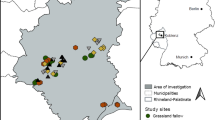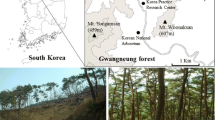Abstract
Agricultural landscapes generally include not only crop fields but also semi-natural habitats. In Japan, such a mixed rural landscape is called “satoyama.” Although ground beetles are potential predators of pests, the environmental factors that determine their distribution in Japanese rural landscapes have not been fully elucidated. To understand the effects of distance from woodland edges, soil moisture, and weed height on assemblages of carabid beetles, we examined the number of adult beetles in pitfall traps placed in a satoyama landscape in the lowlands of western Honshu, Japan. Our results show that the carabid species could be largely differentiated into woodland, intermediate, and open-land species. The “intermediate species” group includes species that depend on woodland or woodland edges for at least part of their life cycles. Paddy fields must have long provided semi-natural habitats that complement those in natural grasslands and wetlands for open-land beetles that prefer wet conditions. Weeds can also increase the abundance of some intermediate and woodland species; thus, the arrangement of such landscape elements as woodlands and paddies can determine the species richness and abundance of ground beetles in agricultural fields.




Similar content being viewed by others
References
Altieri MA, Nicholls CI (2004) Biodiversity and pest management in agroecosystems. Food Products Press, New York
Bedford SE, Usher MB (1994) Distribution of arthropod species across the margins of farm woodlands. Agric Ecosyst Environ 48:295–305
Boulton RL, Richard Y, Armstrong DP (2008) Influence of food availability, predator density and forest fragmentation on nest survival of New Zealand robins. Biol Conserv 141:580–589
Braak T (1986) Canonical correspondence analysis: a new eigenvector technique for multivariate direct gradient analysis. Ecology 67:1167–1179
Delettre YR, Morvan N, Trehen P, Grootaert P (1998) Local biodiversity and multi-habitat use by Empididae (Insecta: Diptera, Empidoidea). Biodivers Conserv 7:9–25
Desender K, Alderweireldt M (1988) Population dynamics of adults and larval carabid beetles in a maize field and its boundary. J Appl Entomol 106:13–19
Fagan WF, Cantrell RS, Cosner C (1999) How habitat edges changes species interactions. Am Nat 153:165–182
Fujita A, Maeto K, Kagawa Y, Ito N (2008) Forest fragmentation affects species richness and composition of ground beetles in urban landscapes. Entomol Sci 11:39–48
Gravesen E, Toft S (1987) Grass fields as reservoirs of polyphagous predators (Arthropoda) of aphids (Homopt., Aphididae). J Appl Entomol 104:461–473
Holland JM (ed) (2002) The agroecology of carabid beetles. Intercept Ltd, Andover
Holland J, Fahrig L (2000) Effects of woody borders on insect density and diversity in crop fields: a landscape-scale analysis. Agric Ecosyst Environ 78:115–122
Hori S (2003) Characteristics of carabid beetles inhabiting isolated forests. Bull Hist Mus Hokkaido 31:15–28 (In Japanese with English summary)
Ings TC, Hartley SE (1999) The effect of habitat on carabid communities during the regeration of a native Scottish forest. For Ecol Manag 119:123–136
Ishitani M (1996) Ecological studies on ground beetles (Coleoptera: Carabidae, Brachinidae) as environmental indicators. Misc Rep Hiwa Mus Nat Hist 34:1–110 (in Japanese with English summary)
Kagawa Y, Maeto K (2007) Laboratory-based study on the predatory ability of Carabus yaconinus (Coleoptera: Carabidae) on larvae of Spodoptera litura (Lepidoptera: Noctuidae). Appl Entomol Zool 42:49–53
Kagawa Y, Maeto K (2009) Spatial population structure of the predatory ground beetle Carabus yaconinus (Coleoptera: Carabidae) in the mixed farmland-woodland satoyama landscape of Japan. Eur J Entomol 106:385–391
Kagawa Y, Ito N, Maeto K (2008) Species composition of ground beetles (Coleoptera: Carabidae and Brachinidae) in an agricultural landscape consisting of a mosaic of vegetations types. Jpn J Ent (NS) 11:75–84 (in Japanese with English summary)
Kago H, Yokogawa M, Fujisawa T, Noma N (2013) The impact of bamboo cutting on species diversity and community structure of ground beetles (Coleoptera; Carabidae) at Riparian forests in the Inukami river. Jpn J Ent (NS) 16:87–96 (in Japanese with English summary)
Landis DA, Wratten SD, Gurr GM (2000) Habitat management to conserve natural enemies of arthropod pests in agriculture. Annu Rev Entomol 45:175–201
Lewis T (1969) The distribution of flying insects near a low hedgerow. J Appl Ecol 6:443–452
Luff ML (1987) Biology of polyphagous ground beetles in agriculture. Agr Zool Rev 2:237–278
Luff ML, Eyre MD, Rushton SP (1992) Classification and prediction of grassland habitats using ground beetles (Coleoptera, Carabidae). J Environ Manag 35:301–305
Lyngby JE, Nielsen HB (1981) The spatial distribution of carabids (Coleoptera: Carabidae) in relation to a shelterbelt: ecologic aspects, plant pests, Denmark. Entomol Meddelelser 44:133–140
Madeira SC, Oliveira AL (2004) Biclustering algorithms for biological data analysis: a survey. IEEE Trans Comput Biol Bioinform 1:24–46
Masuda T (2011) Effects of living mulch on occurrence of insect pests in cabbage field. Plant Prot 65:32–38 (in Japanese)
Matsumoto K (2008) Coppice forest management and ground beetle diversity. Insect Nat 43:20–26 (in Japanese)
Maudsley M, Seeley B, Lewis O (2002) Spatial distribution patterns of predatory arthropods within an English hedgerow in early winter in relation to habitat variables. Agric Ecosyst Environ 89:77–89
McCune B, Mefford MJ (2006) PC-ORD. Multivariate analysis of ecological data. Version 5.10 MjM Software, Gleneden Beach, Oregon, USA
McCune B, Grace JB, Urban DL (2002) Analysis of ecological Communities. MjM Software design, Gleneden Beach, Oregon, USA
Niemelä J (2001) Carabid beetles (Coleoptera: Carabidae) and habitat fragmentation: a review. Eur J Entomol 98:127–132
Niemelä J, Hailia Y, Halme E, Lahti T, Pajunen T, Punttila P (1988) The distribution of carabid beetles in fragments of old coniferous taiga and adjacent managed forest. Ann Zool Fenn 25:107–119
Niemelä J, Langor D, Spence J (1993) Effects of clear-cut harvesting on boreal ground beetles (Coleoptera: Carabidae) in western Canada. Conserv Biol 7:551–561
Petit S, Usher MB (1998) Biodiversity in agricultural landscapes: the ground beetle communites of woody uncultivated habitats. Biodivers Conserv 7:1549–1561
Suenaga H, Hamamura T (2001) Occurrence of carabid beetles (Coleoptera: Carabidae) in cabbage fields and their possible impact on lepidopteran pests. Appl Entomol Zool 36:151–160
Sunderland KD (2002) Invertebrate pest control by carabids. In: Holland JM (ed) The agroecology of carabid beetles. Intercept, Hampshire, pp 165–214
Takeuchi K (2003) Satoyama landscapes as managed nature. In: Takeuchi K, Brown RD, Washitani I, Tsunekawa A, Yokokawa A (eds) Satoyama: the traditional rural landscape of Japan. Springer, Tokyo, pp 9–16
Tanaka K (1956) The ecology of Chlaenius spp. Kontyû 24:87–98 (in Japanese)
Thiele HU (1977) Carabid beetles in their environment. Springer, Berlin
Tscharntke T, Bommarco R, Clough Y, Crist T, Kleijin D, Rand T, Tylianakis J, Nouhuys S, Vidal S (2007) Conservation biological control and enemy diversity on a landscape scale. Biol Control 43:294–309
Tucker G (1997) Priorities for bird conservation in Europe: the importance of the farmed landscape. In: Pain DJ, Pienkowski MW (eds) Farming and birds in Europe. Academic Press, London, pp 79–116
Yamamoto S (2001) Studies on the effect of changes in rural landscape structure on secondary forest plants in Japanese rural areas. Bull Nat Ins Agr Sci 20:1–105 (in Japanese with English summary)
Acknowledgments
We thank Mr. N. Ito of Kawanishi, Hyogo, for the identification of some carabid species. This study was supported by the staff of the Food Resources Education and Research Center of Kobe University, Kasai, Hyogo Prefecture. This study was partly supported by the Global Environmental Research Fund (E-0801 and S-9) of the Ministry of the Environment, Japan.
Author information
Authors and Affiliations
Corresponding author
Rights and permissions
About this article
Cite this article
Kagawa, Y., Maeto, K. Ground beetle (Coleoptera: Carabidae) assemblages associated with a satoyama landscape in Japan: the effects of soil moisture, weed height, and distance from woodlands. Appl Entomol Zool 49, 429–436 (2014). https://doi.org/10.1007/s13355-014-0266-y
Received:
Accepted:
Published:
Issue Date:
DOI: https://doi.org/10.1007/s13355-014-0266-y




